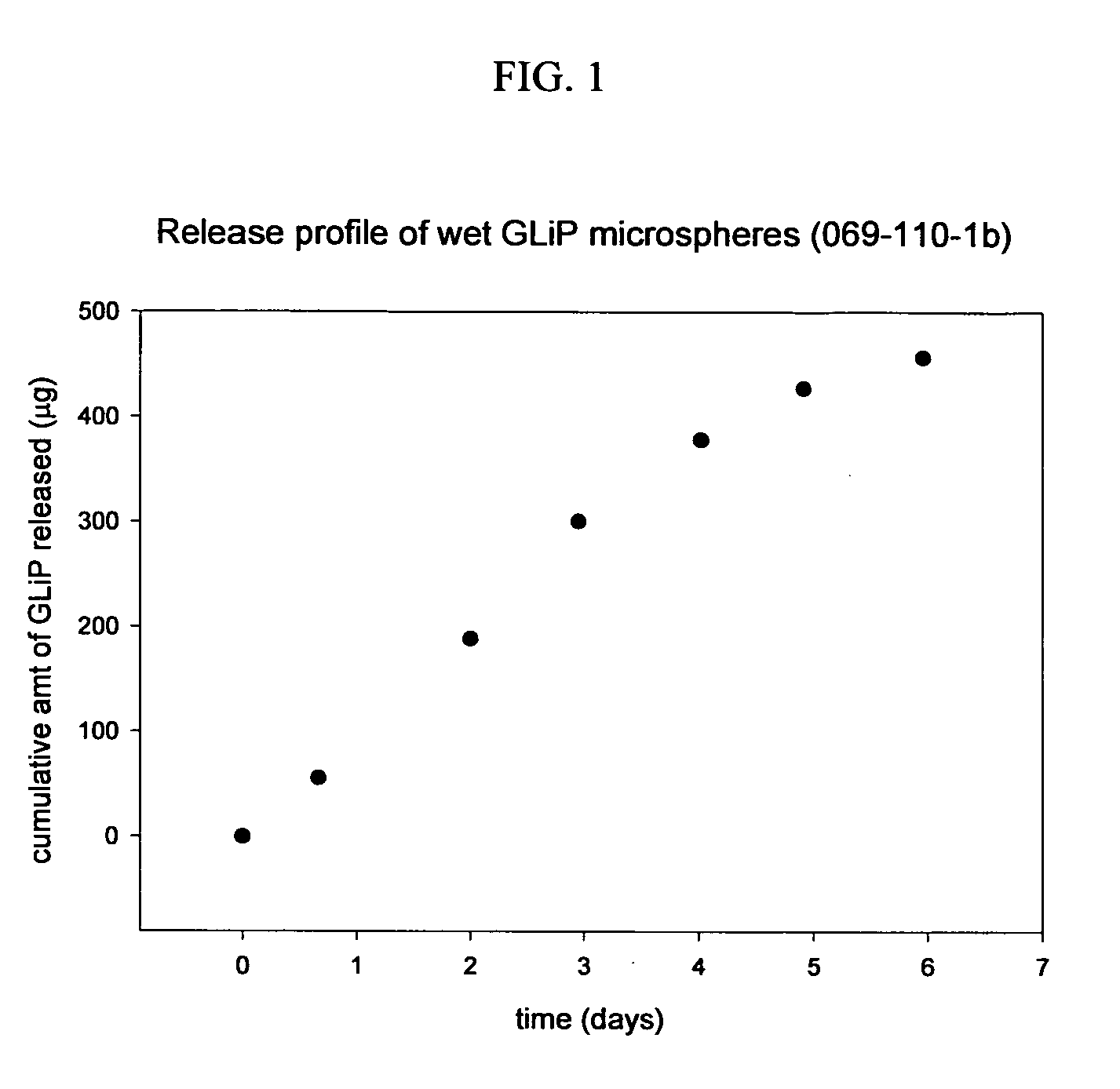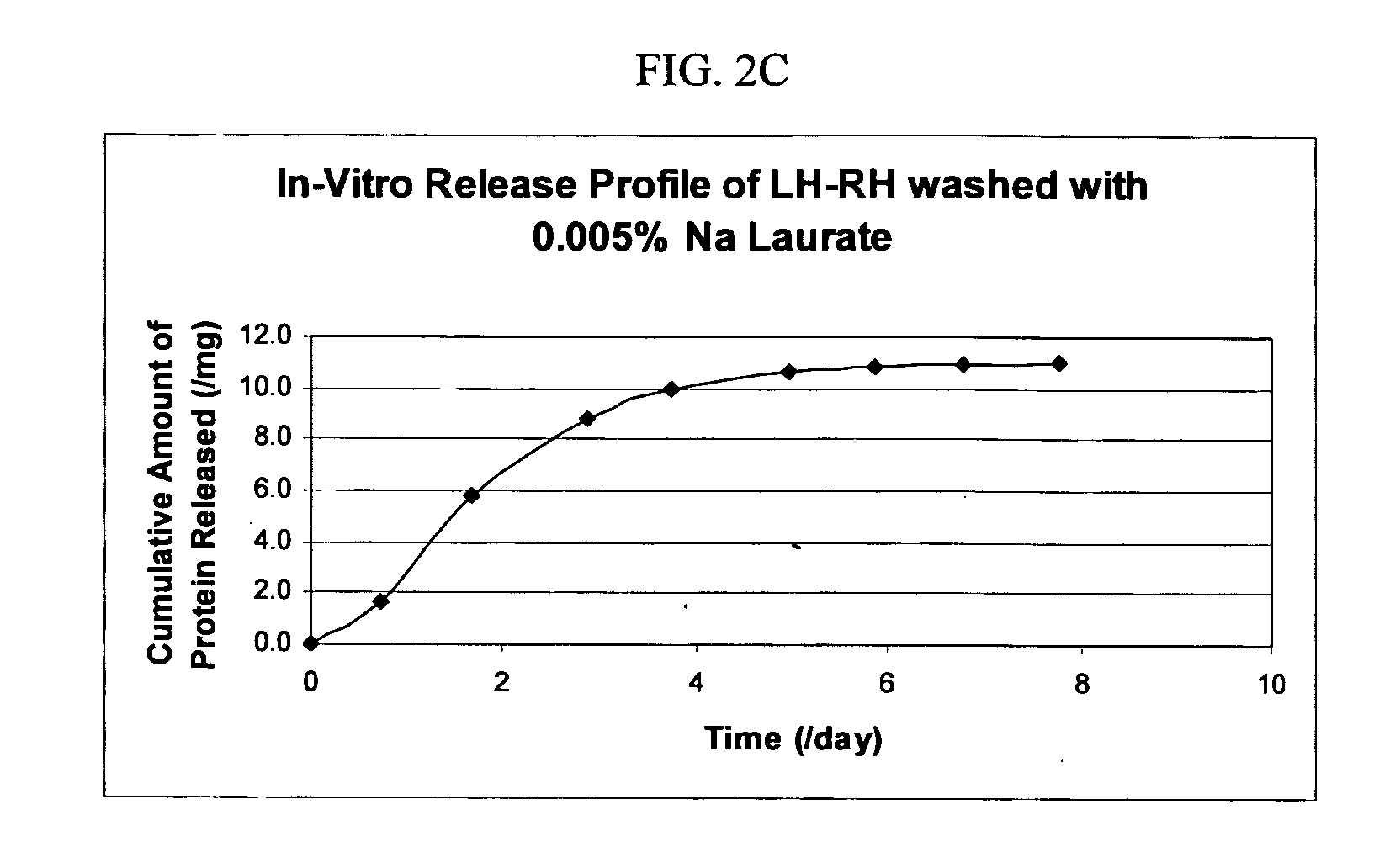Macromer-melt formulations
a technology of macromer and melt, applied in the direction of prosthesis, spray delivery, aerosol delivery, etc., can solve the problems of inability to meet the requirements of patients, patient compliance may be less than optimal, side effects such as nausea, vomiting, delirium, etc., and achieve the effect of low burst
- Summary
- Abstract
- Description
- Claims
- Application Information
AI Technical Summary
Benefits of technology
Problems solved by technology
Method used
Image
Examples
example 1
Controlled Release Formulation of GLP-1
[0142] The process of making controlled release formulation of GLP-1 involves two steps, making a salt of the peptide and encapsulating the salt in a therapeutic article.
[0143] First, a GLP-1 salt was created using 2-acrylamido-2-methyl-1-propanesulfonic acid (AMPS). GLP-1 (between 25 and 50 mg) was dissolved in 1 mL 10 mM PBS buffer. The pH was adjusted to 5.5 by addition of AMPS (50 to 100 mg) until the GLP-1 / AMPS salt precipitates from the solution. The solution was decanted and the precipitate lyophilized. The lyophilized GLP-1 / AMPS salt was then used in the encapsulation procedure.
[0144] Second, 4.4kC5-A3 macromer (1 g) was weighed into a 15 mL centrifuge tube which was heated with a heating block at 50° C. until the macromer completely melted. 2,2-dimethaoxy 2-phenyl acetophenone (DMPA) in 1,4 dioxane (0.125 g of a 15% solution) was added to the melted macromer. This was followed by GLP-1 / AMPS salt (50 mg) and the mixture was heated at...
example 2
Controlled Release Formulation of LH-RH
[0147] The macromer 4.4kC4-A3 (1 g) was heated to 50° C. and, once liquid, mixed with 0.15 g LH-RH, followed by the addition of 0.2 g of 10% DMPA solution in dioxane. The solution was emulsified with Migliyoyl 850. Once emulsified, the macromer was polymerized by exposure to long UV range lamp for a period of 1 hour. After the polymerization, the Migliyoyl 850 was removed by centrifugation, followed by washing with hexane. The hexane was removed from the microspheres by washing the microspheres with different concentrations of Sodium Laurate (0.1%, 0.05% and 0.005%) and monitored for in vitro release. The results are shown in FIGS. 2A, 2B, and 2C, respectively.
example 3
Controlled Release Formulation of Fluticasone Propionate
[0148] The macromer 4.4kC4-A3 (1 g) was heated to about 50° C. and, once liquid, mixed 0.1 g of 15% DMPA solution in dioxane. To this clear solution was added four tablets containing 250 micrograms fluticasone propionate each. The solution was mixed with polypropylene glycol to form an emulsion. Exposure to UV light for 1 hour polymerized the macromer, resulting in fluticasone propionate-containing microspheres. The microspheres were washed with hexane and sterile water followed by lyophilization. The microspheres were monitored for in vitro release. The results are provided in FIG. 3.
PUM
| Property | Measurement | Unit |
|---|---|---|
| molecular weight | aaaaa | aaaaa |
| molecular weight | aaaaa | aaaaa |
| mean size | aaaaa | aaaaa |
Abstract
Description
Claims
Application Information
 Login to View More
Login to View More - R&D
- Intellectual Property
- Life Sciences
- Materials
- Tech Scout
- Unparalleled Data Quality
- Higher Quality Content
- 60% Fewer Hallucinations
Browse by: Latest US Patents, China's latest patents, Technical Efficacy Thesaurus, Application Domain, Technology Topic, Popular Technical Reports.
© 2025 PatSnap. All rights reserved.Legal|Privacy policy|Modern Slavery Act Transparency Statement|Sitemap|About US| Contact US: help@patsnap.com



